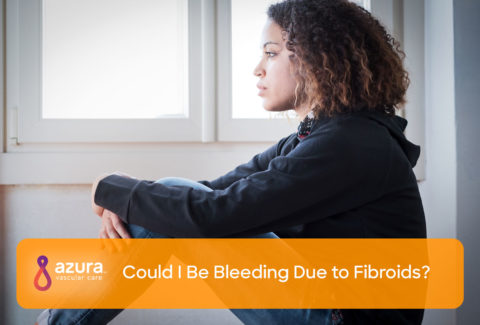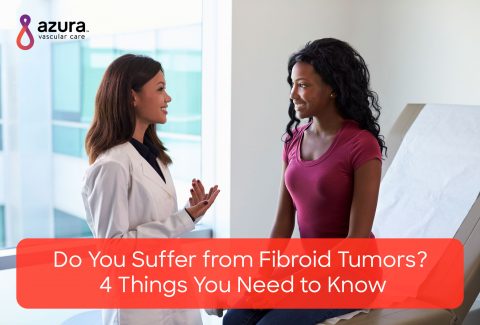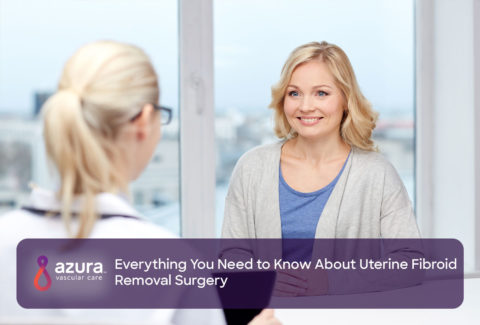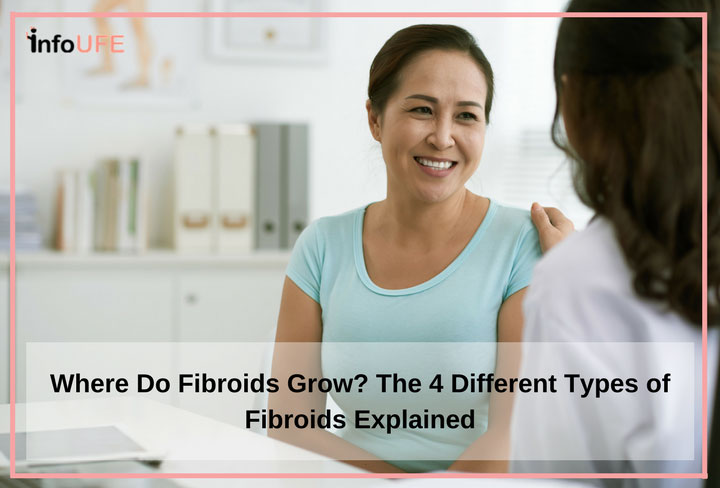
If you’re a woman, chances are you may develop uterine fibroids at some point during your lifetime – for many women, these growths typically appear during the childbearing years.
The good news is that fibroids rarely become cancerous, and they are not associated with an increased risk of cancer.[i] In fact, only about one in 1,000 fibroids are cancerous.[ii]
Understanding Uterine Fibroids
So, what are uterine fibroids?
Also called myomas, uterine fibroids are benign tumors that grow in or on the uterus. Fibroids can be as large as a softball, or smaller than a navy bean. In fact, some fibroids are so small that they cannot be detected by the human eye. In fact, there are four types of fibroids and they can grow alone or in clusters.
The 4 Types of Fibroids
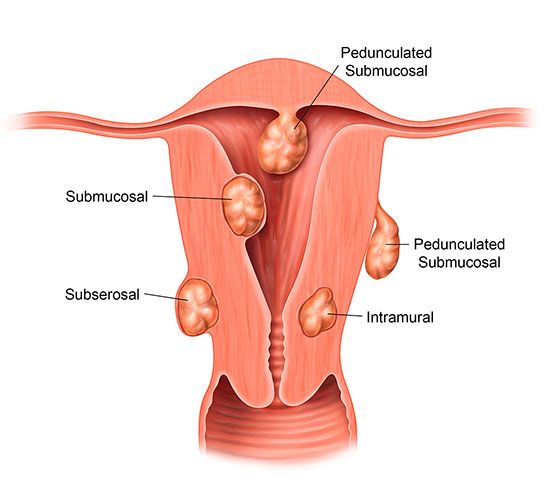
Fibroid types are defined by where they grow in relation to the uterine wall. There are four types of uterine fibroids:
- Submucosal fibroids: Grow in the submucosa, which means just below the thin layer of tissue found in the uterus. These fibroids can protrude into the uterine cavity. These are the rarest type of fibroid.
- Intramural fibroids: Grown in and are contained within the uterine wall. These are the most common type of fibroid.
- Subserosal fibroids: Grown on the outside of the uterine wall.
- Pedunculated fibroids: Types of fibroids that grow on stalks or stems. These stems are attached to the uterine wall and can grow either outside the uterus or inside the uterine cavity.
Symptoms of Uterine Fibroids
It’s actually not at all rare for uterine fibroids to not cause any symptoms at all. That means you might not even know you have them. If you’ve been diagnosed with uterine fibroids, there’s a good chance your doctor discovered them during a routine pelvic exam or when you were having a prenatal ultrasound.
However, some women with uterine fibroids do have symptoms. Some of the symptoms of uterine fibroids you might experience may include:
- Unusual or heavy bleeding
- Painful periods
- A feeling of being full or bloated in your pelvic region
- Pain in your lower back
- Pain or pressure during intercourse
- A need to urinate more frequently
- Reproductive problems and/or complications during pregnancy or labor
Are Some Uterine Fibroids Easier to Remove?
Based on their size and where they are located in relation to your uterus, some fibroids can be easier to remove than others.
Uterine Fibroid Treatment Options
There are several treatment options for uterine fibroids, and you may be surprised to learn that not all treatments require surgery or mean that you won’t be able to have children in the future. Factors that could influence how you choose to treat your fibroids may include whether or not you hope to have children in the future, and how severe your symptoms are.
The four most common procedures to remove uterine fibroids are: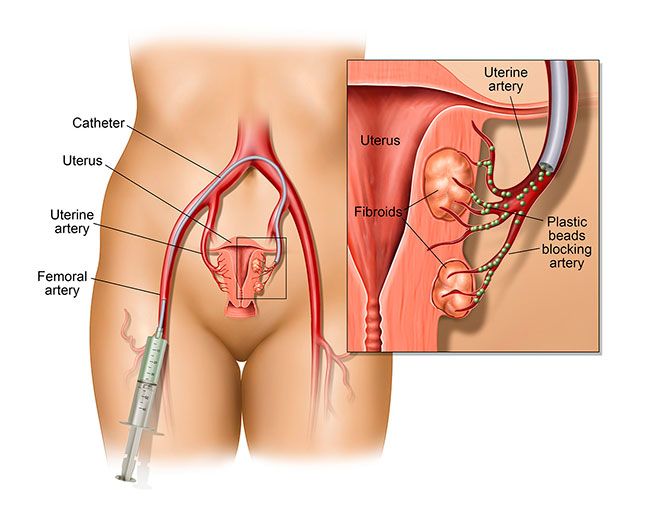
1. Uterine Fibroid Embolization (UFE) – A minimally invasive procedure that is performed by a vascular
specialist, such as an interventional radiologist. During UFE, the vascular specialist will access the femoral artery in the leg or the radial artery in the wrist. He or she will make a tiny nick in the artery and then insert a catheter. A special dye known as contrast, which shows up on an x-ray, helps locate the blood supply to the fibroid(s). This minimally invasive procedure treats the fibroids by starving them of their needed blood supply. UFE is typically appropriate for most sizes and locations of fibroids, except for those that are very large.[iii]
2. Endometrial Ablation – A procedure that destroys the lining of the uterus, along with the fibroids. This procedure is used for small fibroids that are located inside the uterus. Women who have moderate to severe symptoms, such as pain and heavy bleeding, may be a candidate for this procedure.
If you are of childbearing age or hope to have children in the future, it’s important to understand that the chance you’ll be able to conceive after endometrial ablation is unlikely, and the chance of miscarriage is higher if you do become pregnant.[iv]
3. Myomectomy – Can be used to remove all types of fibroids, regardless of where they are located. According to a study by the American Congress of Obstetricians and Gynecologists, myomectomy can relieve uterine fibroids-related symptoms to in 80-90% percent of patients. Doctors can use three different approaches when performing a myomectomy.[v]
- During a hysteroscopy – fibroids are removed using a scope inserted into the uterus through the vagina and cervix.
- During a laparotomy – fibroids are removed through a small incision in the abdomen (and uterus, if necessary).
- During a laparoscopy – fibroids are removed through two small cuts in the abdomen, where a laparoscope is inserted through one cut to locate the fibroids, and a thin tool called a catheter is inserted through the other.
4. Hysterectomy – This most common surgical treatment for fibroids removes the uterus as well as all fibroids. It is often recommended to remove very large fibroids or for women who have extremely heavy bleeding and who are about to enter menopause or who are post-menopausal.[v] It may also be used when other treatments have failed. A hysterectomy can be partial, full or radical, and it will eliminate your ability to have children.
Before choosing any uterine fibroids treatment, you should talk to your doctor so you fully understand the benefits and risks of minimally invasive versus each surgical treatment option. Depending on your individual circumstances, where your fibroids are located and how large they are, a UFE specialist can help determine if you are a good candidate for minimally invasive, uterine fibroid embolization.
Sources:
i Mayo Clinic, Uterine artery embolization, retrieved from: http://www.mayoclinic.org/tests-procedures/uterine-artery-embolization/details/risks/cmc-20205354
ii U.S. Department of Health and Human Services, https://www.womenshealth.gov/publications/our-publications/fact-sheet/uterine-fibroids.html#a
iii Gary P. Siskin1, Meridith Englander, Brian F. Stainken, Jiyong Ahn, Kyran Dowling and Eric G., (200) Embolic Agents Used for Uterine Fibroid Embolization. American Journal of Toentgenology, 175 (3). Retrieved from: http://www.ajronline.org/doi/full/10.2214/ajr.175.3.1750767
iv https://www.nichd.nih.gov/health/topics/uterine/conditioninfo/treatments/Pages/surgical-treatments.aspx
v American Congress of Obstetricians and Gynecologists (ACOG). Retrieved from http://www.acog.org/~/media/For%20Patients/faq074.pdf?dmc=1&ts=20121015T1425097855
